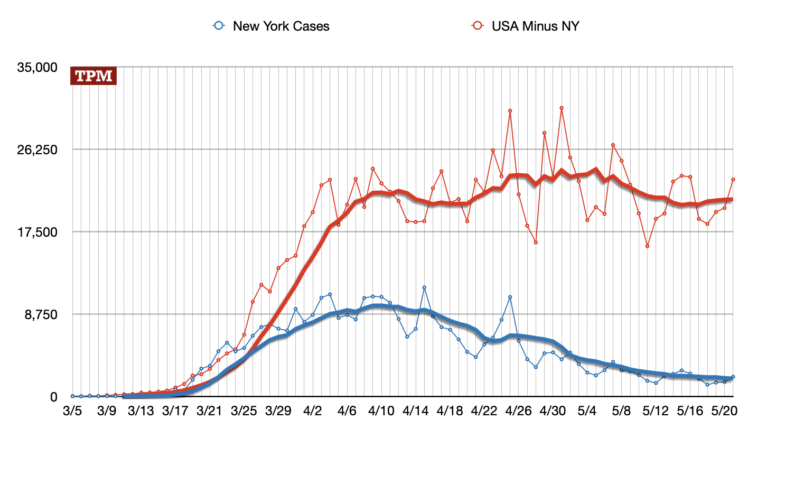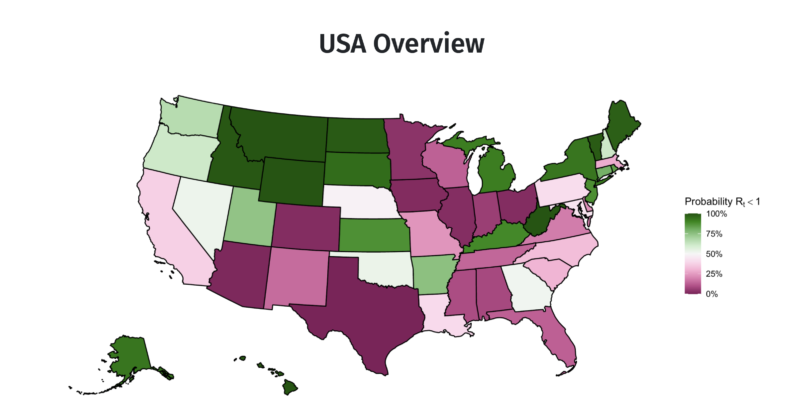We’re getting a mix of information about the state of the COVID epidemic in the United States – much of it contradictory. I wanted to take a few moments to pick apart these seemingly contradictory realities which are happening at the same time.
The first fact is that the initial experiments with easing the strictures on social and economic life have not generated the spikes in new cases that some predicted. Georgia is the clearest case of this. Neighboring Florida is another. We don’t know yet why this is the case. Perhaps we need to wait longer to see the impact. Perhaps continuing mitigation efforts are more effective than anticipated. Perhaps there are cultural, social, epidemiological or even climatic factors that make these states less susceptible to the kinds of outbreaks we saw in New York and other urban centers in the North. But we’ve seen enough data to say with some confidence that the worst predictions are not coming to pass, or at least not quickly.
But there’s another reality that is worth considering. COVID cases across the United States remain notably stable. We may be past the apex but the top looks something like a plateau.
Here are cases across the United States and cases across the United States with New York state graphed separately.


Once New York State is removed from the trend line the rest of the United States looks remarkably stable. Some of this is certainly an illusion created by the steady growth in testing, which has grown dramatically in recent weeks. But even with that, the numbers are coming down quite slowly. Italy had its peak (6,557) of new cases on March 21st and is now at about 1/10th that number (642). Spain had it’s peak (8,271) on March 26th and their drop is even more dramatic (593). That basic pattern is close to the norm in Europe. In other words, other hard hit countries are coming down from their apex of cases much faster than the United States.
Why would this be?
One obvious answer is that the US is doing a worse job and collectively deciding that having COVID running through the population at a high but stable level is okay. But let’s consider some other possibilities. One is simply that the US is a big, big country, not only in population terms but in geographical ones. So more than these other countries we have what are more likely a number of regional epidemics happening in succession. So underneath what appears to be relative stability, with a moderate decline, is actually a series of different regional outbreaks and fall offs unfolding in succession, sort of canceling each other out. This is going to be true in every country where you dig down to the regional or local level. But it can be more true for a country as big as the United States. In epidemiological terms the US is possibly more like Europe as a whole than any individual European country.
So maybe we’ll see this plateau and then a sharper decline coming a bit later.
Here’s one visual which may help put this in perspective, albeit with a breakdown that is more north/south than regional. I mentioned yesterday that researchers at Imperial College London have released a new statistical model to forecast the impact of ‘reopenings’ across the US. Part of their report has this map.

These numbers are fairly intuitive regarding where the epidemic is expanding or receding. It’s basically receding in the places that have had the worst outbreaks to date. That makes sense. A state that is green can simply have its number of cases falling even if the daily number is higher than a state that is reddish. Make of it what you will.
Another possibility is that our testing is growing faster than it is in other countries, thus propping up the number of positive cases. This is definitely the case if we’re trying to distinguish between ‘actual’ prevalence and positive tests. It’s not clear to me that that is significantly the case relative to other countries.
I think the answer so far is that we don’t know. Or to the extent we can know, it’s beyond my analytic abilities to figure out the answer. But it’s not too soon to consider the possibility that while we are not seeing the rolling series of New York style outbreaks, even as many states start loosening their lockdowns, we are also not making the progress that other countries have. We look to be on a course for a long period of endemic disease and numbers of deaths way higher than most of us could have imagined earlier this year.






